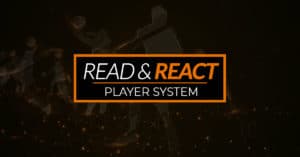Watching the men’s Final Four and more specifically, the championship game, reminded me of one of the reasons I created the Read & React. It has nothing to do with the implementation of the offense; rather, it is how to use the Read & React during a game.
Let me begin by saying that I’m not a college coach and I have no NCAA championship rings. I’m just a student of the game. When I watch games on any level, I’m always looking for something that I can learn and pass on to you – asking myself, “What would I do in this situation? Would I do anything different?”
And of course, I’m always viewing it through the eyes of the Read & React.
With that being said, here’s what I want the Tribe to consider:
“The definition of insanity is to continue to do the same thing over and over again expecting different results.”
Imagine the following scenario. In your preparation for your opponent, you’ve chose to emphasize a particular action – the high ball screen, for example.
But, once you get in the game, it is clear that your opponent can defend that screening action perfectly. In fact, they are defending it so well that you are getting almost nothing from it and the shots that you do get aren’t the ones you want (and even those are going in).
What do you do?
If you were a baseball coach and your pitcher was throwing all fast balls being drilled time and time again, would you tell him to throw better fast balls or would you tell him to throw some change-ups, some curves, or some sliders?
If you were a football coach and the defense was stuffing your every attempt to run the ball, would you tell your team to “run better” or would you begin to throw the ball?
It’s exactly the same in basketball. Although, for some reason, it doesn’t seem as obvious.
If I encountered the above situation, I would want to change my emphasis of action.
And, this happens to be fairly easy with the Read & React. Consider the following in terms of the change of tempo, change of ball movement, change of player spacing, and ultimately the change in scoring opportunities:
Go 5 OUT and Pass & Cut without setting any screens. Avoid any physical contact and turn the offense into a foot race with the ball changing sides of the floor as many times in one possession as possible.
Begin 5 OUT with an emphasis on cutters posting up when they have the chance. Feed the post and choose Laker Cuts or X-Cuts. If nothing is available, kick it out, get out of the post, keep going and try it again with a different player.
The action looks like this: Pass & Cut, Feed the Post and Cut, back to 5 OUT, Pass & Cut, Feed the Post and Cut, etc; inside, outside, inside, outside, etc.
A similar variation of this would be Pass & Cut mixed with Dribble-At. When a Dribble-At occurs (and no lay-up results), the cutter posts up. With this version, everyone on the team knows that only the Dribble-At cutter will post up for the feed.
5 OUT and every cutter seeks to set a back-screen on their way out. As every Read & React coach knows, this will result in Multiple Staggered Screens. Don’t forget that with the clustering that occurs in this action, there will be huge open spaces for dribble penetration.
4 OUT 1 IN and Pin & Skip, Pin & Skip, Pin & Skip until weak-side defenders don’t dare put a foot in the lane. Combine any other layers with this emphasis – you’re just looking to move defensive players until there’s a good Pin & Skip opportunity. Remember, you don’t have to shoot the Skip pass. You can catch and drive, catch and feed the post, catch and pass and cut, catch and Dribble-At, etc.
Pass & Cut in any formation with the intention of hunting Draft Drives or Intelligent Drives. You are looking to break down the defense by combining two actions – passing actions and dribble penetration actions.
This list is potentially endless – that’s why I made the Variations DVD. These variations could be given a color code, a name, or a number so that they can be worked on during practice or called from the sideline in a game.
The next time your opponent is prepared for your offensive actions, you will have the ability to change gears (tempo, spacing, screening or cutting actions) and offer your players different scoring opportunities. The Read & React lets you do this without changing your offense.
And, of course, you might still lose anyway, but hey, it’s my responsibility to give my players a chance to win. Changing gears gives them that chance.
If any of you Tribe members have “game-coached” the Read & React in this manner, I would love to hear your examples. I’ve already talked to a few who coach it this way, so I know you’re out there! Let me know in the comments section.






